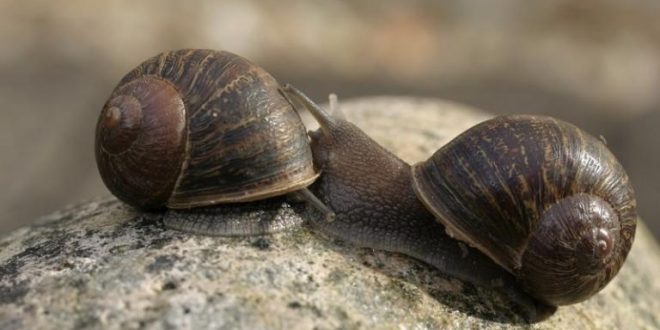Researchers are seeking the public’s help in finding a mate for a lonely snail using the twitter hashtag #snaillove.
Scientists at Nottingham University are hoping to study the genetics of the lefty snail, but to do so they will need more of its kind. And to make lefty snail babies, they will need for the snail – dubbed Jeremy – to mate.
The problem is that as well as having a lefty shell, Jeremy also has lefty genitals – on the opposite side to his righty counterparts.
Dr Angus Davison, associate professor and reader in evolutionary genetics in the University’s School of Life Sciences, said: “This really is an exciting find — I have been studying snails for more than 20 years and I have never seen one of these before. We are very keen to study the snail’s genetics to find out whether this is a result of a developmental glitch or whether this is a genuine inherited genetic trait.”
However, for Nottingham’s ‘lefty’ snail — dubbed Jeremy — being special comes with a unique set of problems. In addition to its mirror-image shell, the snail’s genitals are also on the opposite side to the more common dextral snails — making it very difficult for the two types of snails to mate.
Dr Davison added: “Snails are hermaphrodites meaning that if they want to they can reproduce on their own without the need for another mate. However, they don’t really like doing this and from our perspective, the genetic data from offspring of two lefty snails would be far richer and more valuable to us.”
Jeremy the snail was originally found around a compost heap in Rayne’s Park, South West London by a retired scientist from the Natural History Museum, who spotted its unique traits. Having heard about Dr Davison’s interest in snail genetics, he contacted the Nottingham scientist before sending it on — by snail mail.
Earlier this year, in research published in the journal Current Biology, Dr Davison and colleagues at universities in Edinburgh, Germany and the US, revealed they had discovered a gene that determines whether a snail’s shell twists in a clockwise or anti-clockwise direction.
The same gene also affects body asymmetry in other animals — including humans — and research using these snails could offer the chance to develop our understanding of how organs are placed in the body and why this process can sometimes go wrong when some or all of the major internal organs are reversed from their normal placement.
Now the hunt is on for a second sinistral brown garden snail to mate with Jeremy and Dr Davison is appealing to the public to get involved by searching hedgerows, borders and plant pots for this rare variety of the common snail.
“This is something which everyone can get involved with and which you can easily do on your own doorstep. It is an example of citizen science at its best. There is a chance, because it is such a rare thing, that anyone who can find and identify another of these sinistral snails may even find themselves named as a contributor on a research paper we publish in the future as a result of this.”
Agencies/Canadajournal
 Canada Journal – News of the World Articles and videos to bring you the biggest Canadian news stories from across the country every day
Canada Journal – News of the World Articles and videos to bring you the biggest Canadian news stories from across the country every day




I have a bowl, some garlic, some cheese and butter. Bring it on, I’ll show you true snail love.